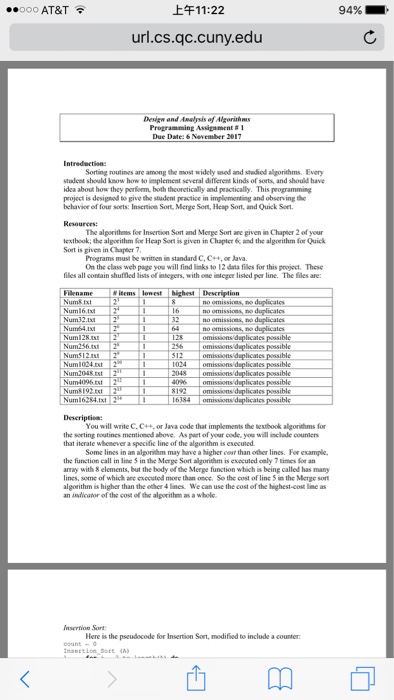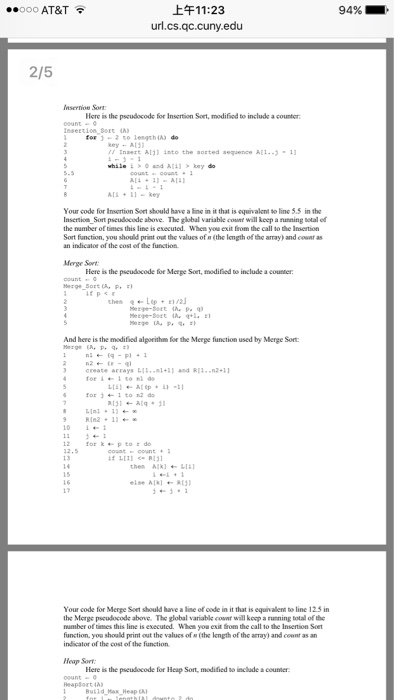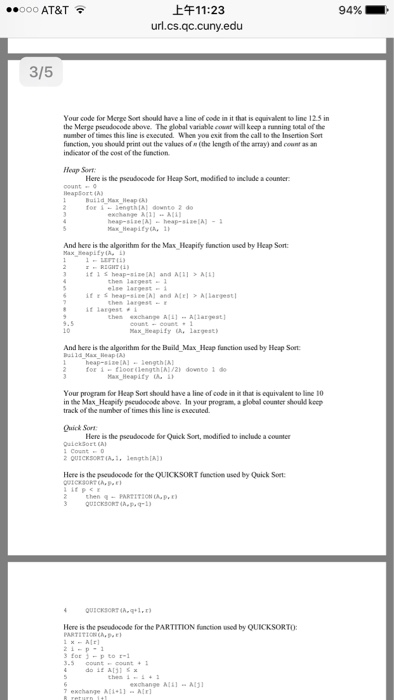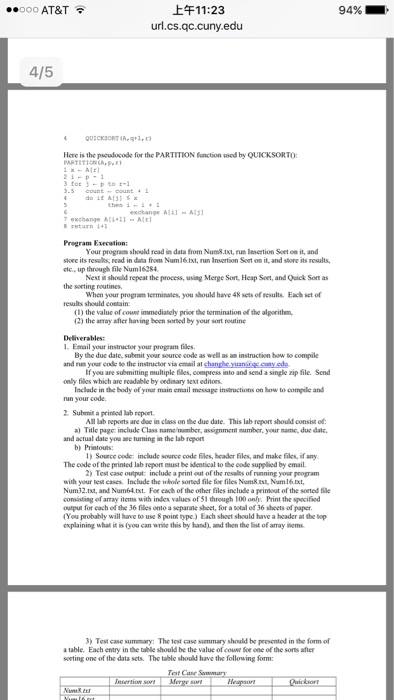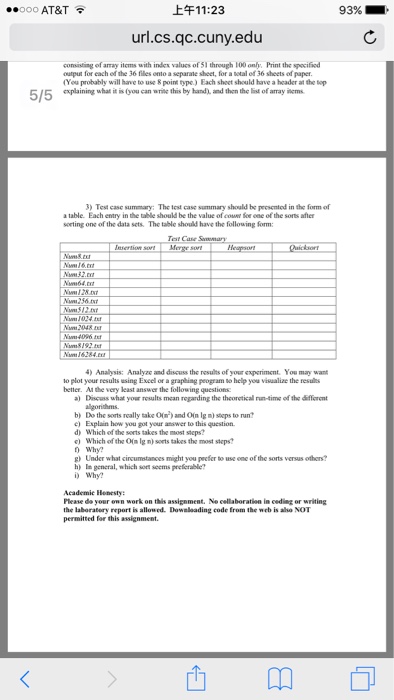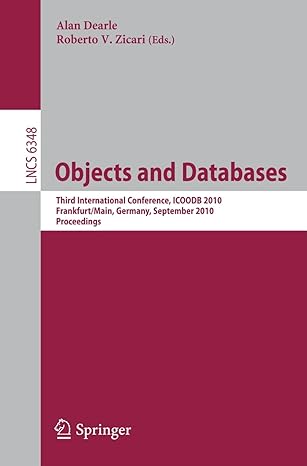AT&T 11:22 94% url.cs.qc.cuny.edu Desigw and Anslysis ef Algoris Date: 6 Nevember 2017 Sorting routines are among the most widely wsed and stedied algorithms. Every student should know how to implement several different kinds of sorts, and should have idka about how they perfiorm, both theoretically and practically. This peogramming project is designed to give the shudent practice in implementing and observing the behavice ef four soets: Inserticn Sot, Merge Sot, Heap Sort, and Quick Seet. The algorithms for Insertion Sort and Merge Sort are given Chaper 2 of your lextbook; the algoeithm Soe Heap Sont is given in Chaptcr & and the algoeithm or Quick Sort is given in Chapter 7 Programs must be wnmen standard C, C++, or Java. On the class web page you will find links to 12 data files for this peoject. These lists of integers, with one integer listed per line. The files are: files all contain shufiled Fienameieems lonest stDescription Nums ixt no omissicns, no duplicats no omissices, no duplicales no omissicns, no duplicales Num4.tt Num128.ts Num256 128 omissions daplicates Num1024t Num2048Est Num4096tst 8192 omissions duplicates possible Numl6284.txt Descriptiem: You will write C.C+ or Java code that implements the testbook algonithms for the sorting routines mentioned above. As part of your code, you will inclade counters that iterate whenever a specific line of the algorithm is execuied Some lines in an algonthm may have a higher cest than other lines. For example, the function call in line S in the Merge Sort algorithm is eseculed only 7 times Soe an anray with 8 elements, but the body of the Merge function which is being called has many lines, some of which are excquted more than onpe. So the cost of line S in the Merge sort algorithm is higher than the ether 4 lines. We can use the cost of the highest-cost line as an indicator of the cost of the alporithm as a whole nsertion Sort Here is the pseudocode for Insertion Soet, modified to include a counter AT&T 11:22 94% url.cs.qc.cuny.edu Desigw and Anslysis ef Algoris Date: 6 Nevember 2017 Sorting routines are among the most widely wsed and stedied algorithms. Every student should know how to implement several different kinds of sorts, and should have idka about how they perfiorm, both theoretically and practically. This peogramming project is designed to give the shudent practice in implementing and observing the behavice ef four soets: Inserticn Sot, Merge Sot, Heap Sort, and Quick Seet. The algorithms for Insertion Sort and Merge Sort are given Chaper 2 of your lextbook; the algoeithm Soe Heap Sont is given in Chaptcr & and the algoeithm or Quick Sort is given in Chapter 7 Programs must be wnmen standard C, C++, or Java. On the class web page you will find links to 12 data files for this peoject. These lists of integers, with one integer listed per line. The files are: files all contain shufiled Fienameieems lonest stDescription Nums ixt no omissicns, no duplicats no omissices, no duplicales no omissicns, no duplicales Num4.tt Num128.ts Num256 128 omissions daplicates Num1024t Num2048Est Num4096tst 8192 omissions duplicates possible Numl6284.txt Descriptiem: You will write C.C+ or Java code that implements the testbook algonithms for the sorting routines mentioned above. As part of your code, you will inclade counters that iterate whenever a specific line of the algorithm is execuied Some lines in an algonthm may have a higher cest than other lines. For example, the function call in line S in the Merge Sort algorithm is eseculed only 7 times Soe an anray with 8 elements, but the body of the Merge function which is being called has many lines, some of which are excquted more than onpe. So the cost of line S in the Merge sort algorithm is higher than the ether 4 lines. We can use the cost of the highest-cost line as an indicator of the cost of the alporithm as a whole nsertion Sort Here is the pseudocode for Insertion Soet, modified to include a counter
